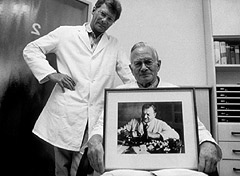| |
|
When I was only four or five years old, my
dad had three eyes: two that were perfectly
healthy, and a third one I knew nothing of.
One day he had me awed: he awkwardly
fumbled one of his eyes, and when his hand
came away – him keeping his lid closed –
that very eye looked at me from where it was
lying in his palm! Wow, I didn’t know that you
could actually do that! It took me years to
figure out that he had fooled me with a glass
eye. No wonder the trick never worked with
my own eyes. My dad has forgotten about the
incident, and the glass eye itself is missing.
However, the episode has made a lasting
impression on me, so that decades later I
started to wonder how glass eyes are made
in the first place? I wanted to do a picture
story on this wonderfully skewed subject.
Research was unusually easy. One call at
a local ophthalmologist’s was all it took to
find 75-year-old Alfred Greiner, my dream
|
|
ocularist in his Institute for Artificial Eyes in
Munich, Germany.
He manufactures glass
eyes in third generation, even his father and
grandfather before him have worked in this
rare profession, as does his son and partner.
Despite his old age, Greiner works with
remarkable accuracy and love of detail.
His bizarre trade requires seven years of
training, exceptional manual skills, and great
sensitivity. Many a patient travels far to
have a new eye prosthesis fitted by Greiner.
One lady even flies over from Argentina
every five years for this purpose.
Few tools are necessary to make artificial
eyes from tubes of white glass and sticks of
clear or coloured glass, many of which even
date back to the days of Greiner’s grand-
father: a propane gas burner, some special
tongs, a pair of dividers, a couple of crucibles.
All this looks rather primitive and fits on a
small workbench.
|

